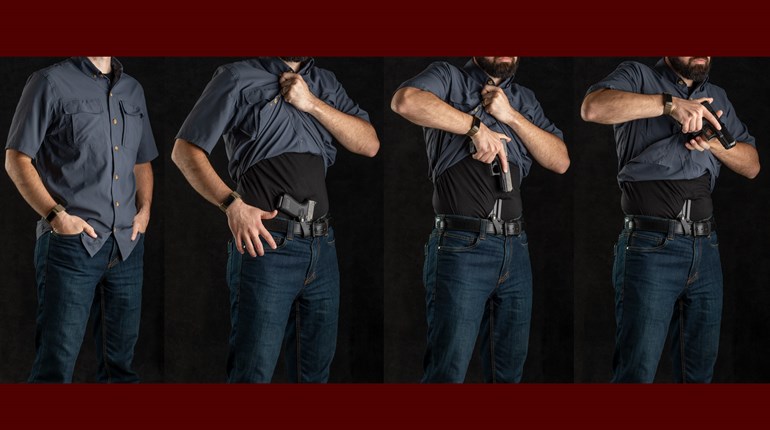
The appendix-carry setup shown above features a Glock G19 inside of a PHLster Skeleton holster. A spare Magpul GL9 PMag is carried in the accompanying Skeleton magazine carrier.
My hands were raised shoulder-high in a non-threatening posture as I walked away from the armed robber behind me. He had me cold, and I felt fortunate he’d been satisfied with the car keys, when I heard my companion yelling behind me. Apparently I was the only one being allowed to walk away.
I dropped the flashlight I’d been holding in my left hand and, as I fumbled for it while it clattered to the ground, I thought “If I’d been carrying appendix-style, this would have been the perfect time to draw…”
As it was, I didn’t want to risk a huge telegraphing move of reaching behind my right hip with the bad guy right behind me a dozen feet away, so I raised my hands again and kept walking around the corner before drawing and coming back to try and rescue my friend in a botched marking-round gunfight that left me bruised and stinging when the lights in the imaginary “city street” were turned back on.
Appendix Inside-the-Waistband, appendix carry or AIWB for short, first came to my attention because of the speed it allowed on the draw, but as the years have gone by, I’ve learned of or observed so many other benefits of this style of carry that I’ve decided to make the jump from my usual inside-the-waistband, 4-o’clock carry position.
One of those benefits is the one I mentioned in the opening paragraphs: It’s so much easier to make a surreptitious draw. As long as your hands are free and somewhere around your waistline, you can move straight into the drawstroke without the distinct telegraphing reach-behind-the-hip that conventional strong-side carry requires. (Especially for those of us who are short-waisted and long-armed, because loading up a conventional strong-side IWB draw tends to involve a very identifiable shoulder motion.)
Another thing I noticed from watching force-on-force evolutions and attending classes like Craig Douglas’ Extreme Close Quarters Concepts (ECQC) was how much easier it was to foil an attempted gun grab with an appendix-carry setup, or to retain the gun in its holster should someone notice it in a grapple and try to snatch it. Simply bending double at the waist can trap the gun pretty effectively, or at least buy time to solve the retention problem with your hands.
It doesn’t hurt that, after ECQC, I tend to think a lot more about retention issues. Grocery store lines make me itch now. Because I now know that while “concealed means concealed,” if I’m within arm’s length of someone, a holstered gun isn’t my gun or their gun, it’s our gun.
I’ve turned a full 180 on some of the issues with holstering, too. Conventional wisdom is that putting the gun away in an appendix-carry holster is more dangerous than juggling nuclear hand grenades, while putting a gun away in a conventional strong-side holster is somehow safe as houses.
Yet, there are training academies that disallow IWB carry, period, because of incidents that occurred while holstering, and even a conventional outside-the-waistband holster is no proof against mishandling.
Care should always be taken when holstering a loaded firearm, and an appendix-carry holster offers the advantage of being able to visually observe that the gun is going into the holster cleanly and that there are no obstructions in the holster’s mouth just waiting to snag the trigger and cause trouble.
Further helping to ease my fears, John Johnston, host of Ballistic Radio and half of the training team at Citizen’s Defense Research, did a video using a Simunition Glock and a cutaway holster demonstrating that holstering a firearm in the appendix-carry position was a lot safer than I’d previously assumed.
So, that gives us the advantages of being able to more effectively launch a surreptitious draw, easier weapon retention and having the gun up front and in one’s general field-of-view, which can aid in both retention and safe holstering in a training environment.
That leaves the thing that first attracted my attention: Speed of the draw. This is simple mechanics, since the hands don’t have to travel as far to get to the gun, and the gun doesn’t have to travel as far to be brought into the firing position.
The speed advantage is enough that in an action shooting sport like USPSA, simply moving your holster forward of your hip is disallowed in Production Division. This means that if you want to run your appendix-carry gear in a USPSA match, you’ll be shooting in Limited Division.
While the speed advantage isn’t as great if two hands aren’t available, a strong-hand-only draw from the appendix-carry position is not as impossible as I was once led to believe. If the other hand is occupied, the shooter simply grabs the hem of the closed-front cover garment, lifts it high on the chest to clear the holstered pistol, and then traps the cover garment with their upper arm and before completing the strong-hand-only draw.
So, what are the downsides? Performing a safe reholster while seated is a lot more involved than when using a strong-side holster, obviously. Most notably, appendix carry in comfort takes a lot more experimenting with holsters, belts, ride height, etc., before a comfortable solution can be found. I’m still in search of the perfect belt myself.
Still, though, the upsides of the method are enough that I’m at least going to be exploring it. The rig will get an extended evaluation this time, and we’ll see if it sticks.






































